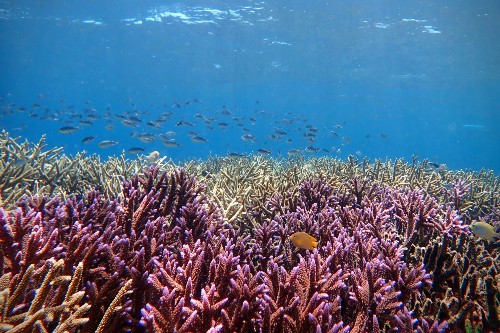Thousands of square metres of coral are being grown on previously destroyed reefs in Indonesia, but previously it was unclear whether these new corals would revive the entire reef ecosystem.
Now a new study, led by researchers from the University of Bristol and the University of Exeter, finds a heathy, diverse soundscape on the restored reefs.
These sounds - many of which have never been recorded before - can be used alongside visual observations to monitor these vital ecosystems.
Professor Steve Simpson of Bristol’s School of Biological Sciences, said: "Some of the sounds we recorded are really bizarre and new to us as scientists.
"We have a lot still to learn about what they all mean and the animals that are making them. But for now, it’s amazing to be able to hear the ecosystem come back to life."
Lead author Dr Tim Lamont, of the University of Exeter and the Mars Coral Reef Restoration Project, which is restoring the reefs in central Indonesia, added: "Restoration projects can be successful at growing coral, but that’s only part of the ecosystem. This study provides exciting evidence that restoration really works for the other reef creatures too - by listening to the reefs, we’ve documented the return of a diverse range of animals."
The soundscapes of the restored reefs are not identical to those of existing healthy reefs - but the diversity of sounds is similar, suggesting a healthy and functioning ecosystem.
There were significantly more fish sounds recorded on both healthy and restored reefs than on degraded reefs.
This study used acoustic recordings taken in 2018 and 2019 as part of the monitoring programme for the Mars Coral Reef Restoration Project.
The results are positive for the project's approach, in which hexagonal metal frames called ‘Reef Stars’ are seeded with coral and laid over a large area. The Reef Stars stabilise loose rubble and kickstart rapid coral growth, leading to the revival of the wider ecosystem.
Mochyudho Prasetya, of the Mars Coral Reef Restoration Project, said: "We have been restoring and monitoring these reefs here in Indonesia for many years. Now it is amazing to see more and more evidence that our work is helping the reefs come back to life."
Professor David Smith, Chief Marine Scientist for Mars Incorporated, added: "When the soundscape comes back like this, the reef has a better chance of becoming self-sustaining because those sounds attract more animals that maintain and diversify reef populations."
Asked about the multiple threats facing coral reefs, including climate change and water pollution, Dr Lamont said: "If we don't address these wider problems, conditions for reefs will get more and more hostile and eventually restoration will become impossible.
"Our study shows that reef restoration can really work, but it's only part of a solution that must also include rapid action on climate change and other threats to reefs worldwide."
The study was partly funded by the Natural Environment Research Council and the Swiss National Science Foundation.
The paper, published today in the Journal of Applied Ecology, is entitled: 'The sound of recovery: coral reef restoration success is detectable in the soundscape.'
Paper:
‘The sound of recovery: coral reef restoration success is detectable in the soundscape’ by Dr Tim Lamont, Professor Steve Simpson et al in Journal of Applied Ecology.


